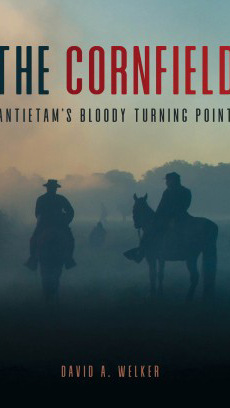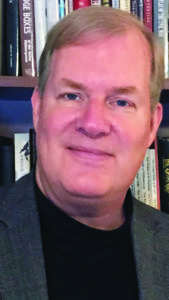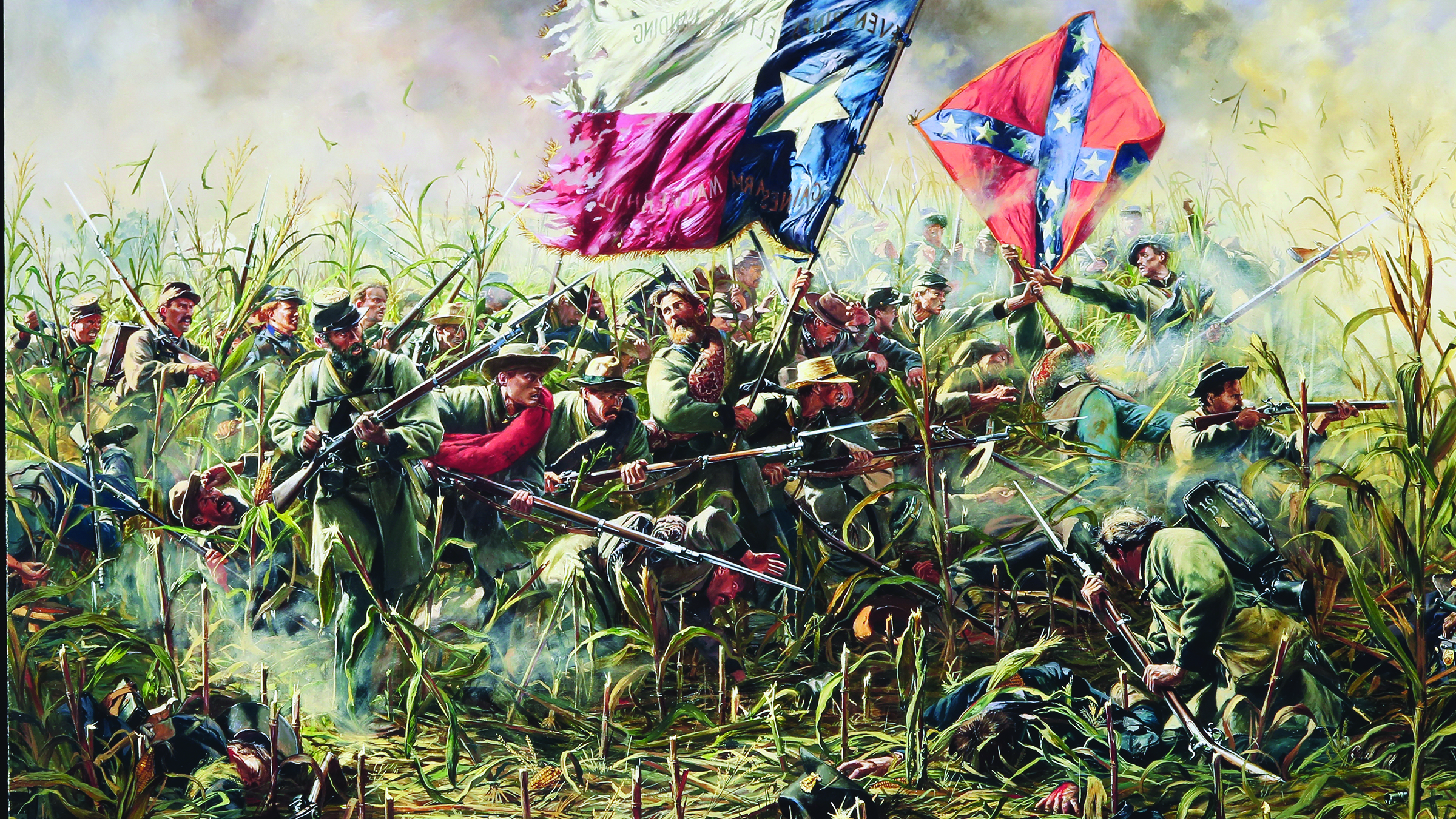Union possession of the most important ground on the Antietam battlefield came only after critical errors
There’s no understating the Battle of Antietam’s significance, coming as it did during such a crucial period of the war in September 1862, when international support of the Confederacy remained strong. It is also clear that the men on both sides understood just how high the stakes were when they clashed at Sharpsburg, Md., throughout the day September 17. In his new book, David A. Welker shows the evidence of those sentiments during the ferocity of battle in and around the section of the battlefield known as the Cornfield. The Cornfield: Antietam’s Bloody Turning Point (Casemate, 2020, $34.95) is a fascinating study on this brutal struggle that helped decide the battle for the Union.
What interests you so much about the intense struggle for the Cornfield that morning?

By David A. Welker
Casemate, 2020, $34.95
From my earliest study of the war, I was fascinated by the idea that its events could transform otherwise mundane spots into unique and special places, with Antietam’s Cornfield being one of the most singular. One of my ancestors, Robert W. Austin of the 105th New York, was wounded in the Cornfield, and I wanted to know more about his experience and my family’s connection to that hallowed place as well as others. Eventually this all came together as I began studying Antietam in some depth while building a staff ride program for my government job. Most modern accounts of the Cornfield either emphasized only one part of the fight, such as the Iron Brigade’s attack, or glossed over the complicated swirl of action before moving on to discuss more straightforward parts of the battle. My growing passion for studying and learning the meaning of the events in the Cornfield finally led me to write this book, to record and share my findings with others.
Of all the decisions that commanders made north of Sharpsburg, which probably had the greatest impact?
One of the most interesting and important decisions—as well as underconsidered—was the one by Joe Hooker to change how he used his reinforcements, Mansfield’s 12th Corps. Hooker’s initial deployment of the 12th corps suggests he intended to send it over the same ground and in the same manner as his by-then battered and spent 1st Corps, attacking directly south through the Cornfield right into the jaws of the Confederate salient Stonewall Jackson had created. Barely after Mansfield began deploying his two divisions—which extended from the Hagerstown Pike to the East Woods—Hooker unexpectedly changed his mind. His revised instructions have one division clearing and securing the East Woods while the second pivots on that position to eventually strike due west toward the Dunker Church and turn the vulnerable end of Jackson’s salient defending the Cornfield. Hooker, it seemed, suddenly learned every lesson the early morning’s disastrous fighting had to offer. Doing so allowed the Union to finally take the Cornfield and get George McClellan’s attack back on track.
What does the Cornfield showdown teach us about leadership in the Civil War?

n many respects, the Cornfield action is a microcosm of Civil War leadership challenges because nearly all the many complications, large and small, are present in those few hours of battle. One challenge it most clearly reveals is that communication between leaders—a key element of command unity—is critical to operational success. Every senior officer knows that confusion will intrude to frustrate their plans, even before the shooting starts, and that lacking our modern, constant means of communication, only the transmission of clear, honest communication can begin mitigating that challenge. Throughout the Cornfield fight, communication breakdowns led to failure—between Union commanders from corps though brigade level in Hooker’s opening assault; between John Bell Hood and his brigade commanders during his counterattack; between Generals George Greene and “Bull” Sumner before and after the attack into the West Woods; and so forth. At the same time, good communication paved the path to victory in the Cornfield. Communication was coordinated among Jackson, Robert E. Lee, and James Longstreet most of the day, and between Hooker and Mansfield before Mansfield was mortally wounded—and with Alpheus Williams and the 12th Corps commanders who assumed new roles amid the fighting.
Joe Hooker, Joseph K.F. Mansfield, and, especially, Edwin V. Sumner have fared badly at the hands of students of the Civil War, while the opposite is generally true of Stonewall Jackson’s generalship in September 1862. Is this justified?
Generally, it is, but I think it remains important to note the exceptions to these judgments. Jackson certainly deserves credit for creating strategic depth before his otherwise quite weak Confederate position on the Dunker Church ridge and making the Union fight for an intermediate objective, the Cornfield and the surrounding ground between the East and West Woods. In my estimation, this fact is central to the Army of Northern Virginia’s holding its position at Antietam as long as it did and avoiding disaster. At the same time, Jackson failed to control or exploit the morning’s many Confederate counterattacks, which at a considerable manpower cost achieved little more than blunting or pushing back various Union advances, so that when the time came to implement Lee’s turn to the offensive, Jackson simply lacked the men or positioning to carry that out. Similarly, although Hooker, Mansfield, and Sumner all committed key—and some major—mistakes, each at particular points demonstrated effective decision making and leadership that morning. Hooker eventually learned and implemented those lessons, setting the Union on the path to victory; Mansfield’s personal repositioning of his troops under fire set the stage for that victory; Sumner seized the advantage and attacked quickly and boldly, which might have secured an earlier and decisive Union victory had he sustained his West Woods assault.
Which Union commander’s performance north of Sharpsburg do you feel has been underappreciated by students of the battle? Which Confederate commander’s?
On the Federal side, I think General Mansfield’s performance has been the most consistently underappreciated. Hooker’s sudden change in tactics amidst the swirl of battle required Mansfield to redeploy his entire 12th Corps quickly and efficiently under fire. Historians have generally viewed Mansfield’s personally leading various brigades and regiments into position as a sign of leadership failure, of micromanagement that reflects a lack of trust in his division and brigade commanders. Mansfield’s having been with his new command for only five days certainty impeded the building of rapport with his officers or his gaining trust in the mix of inexperienced and veteran regiments, but Hooker’s impending attack and constant fear of another Confederate counterattack left no time or room for error, such as a mispositioned unit or misunderstood orders. Mansfield’s actions set the stage for Union possession of the Cornfield, which came at the cost of his life.
On the Confederate side, one of the several who stand out is D.H. Hill. Although Hill is rightly associated most with defending the Sunken Road midday, his actions late on the 16th and throughout the early morning fight played a critical role in allowing Jackson’s salient to withstand repeated Federal assaults. D.H. Hill’s effective use of the terrain and position created depth for his brother-in-law Jackson’s salient south of the Cornfield, just as Jackson’s salient created depth for the main Confederate line. Similarly, his battle awareness enabled sending brigades forward at just the right moment to support Jackson’s hold on the Cornfield. Just as Jackson’s actions undergirded Lee’s efforts, D.H. Hill’s supported Jackson’s.
What enabled the men in the ranks who fought in the Cornfield to fight so hard and well for so long?
For the most part, I think that like in the war’s other battles, men were motivated largely by a very personal sense of duty, wanting not to let down their friends and comrades in the ranks, and their loved ones at home. This is frequently mentioned in accounts of those who fought in the Cornfield. Many on both sides also understood the battle’s importance and saw a connection between their fighting and higher, national goals. Confederates believed victory would extend their stay in Maryland and advance Southern independence; for Federals, it meant mitigating the sense of failure remaining from Second Manassas and driving the enemy back to Virginia and preserving the union. These men were not automatons, just doing their rote duty; they believed in and were motivated by their respective causes. You frequently see these national objectives mentioned by Cornfield survivors, almost as if they were reminding themselves and those to whom they were writing why they could endure the Cornfield’s intense combat experience and suffering.
What was the legacy of the Cornfield for the men who fought there? How did the experience of fighting for the Cornfield shape how soldiers and leaders made decisions and conducted themselves on future battlefields?
Those who endured Antietam’s Cornfield carried the experience throughout their lives as a mark of horrific honor. The mere mention of having been there told of courage and sacrifice. This is why the 6th Wisconsin’s Major Rufus Dawes would write, “Whoever stood in front of the corn field at Antietam needs no praise.” Unfortunately for the soldiers and the course of the war, I think many who fought in the Cornfield learned precious little beyond that because you see many mistakes that created such high casualties there, for very little or no military gain—lack of planning, rigid adherence to obsolete plans, communication failures, ignoring terrain and position opportunities—repeated throughout the war. Certainly, those who were there learned personal lessons and applied them in directing or fighting portions of future battles, but there was simply no larger effort to study and learn from the events of Miller’s Cornfield.
Is there a spot on the battlefield you find especially personal?
I have several, although in many respects the entire battlefield is a national treasure. But two stand out to me. One is at the Cornfield’s southern fence, on the battlefield’s modern Cornfield Avenue. Being here gives one the same view that Jackson’s defenders had at dawn, and you can imagine what Colonel Abram Duryée’s Federals must have experienced coming alone through the corn before emerging, and the nearby actions that were spawned. The other is on the western edge of the East Woods, in a swale just north of the Cornfield. Standing there and looking toward the West Woods gives one a real sense of the importance terrain played for Hooker’s attackers and throughout this battle—as well as the many missed opportunities.
Your previous book was a study of the September 1862 fight at Ox Hill. What have you’ve been reading since then and has the process of preparing this book led you to rethink about the war in general and that engagement in particular?
Research for both books and some more recent work I’ve done looking at the fighting at Petersburg in 1864 has intensified my wonderment at just how slowly officers, on both sides and at all levels, responded to the changes wrought by new technologies and the events of the war itself. One would think that the carnage of any one of these battles—or just in the Cornfield itself—would have forced collective introspection and some coordinated effort to learn and improve, to do better next time. That it did not was certainly due in part to the era, when admitting mistakes was often seen as reflecting deep personal weakness and failings, but it still puzzles me why more tactical and operational change didn’t occur at least quietly after each battle. This is particularly true on the Confederate side after Ox Hill, because Lee and his senior commanders, as far as we know, didn’t evaluate the events of September 1, 1862, and simply swept under the rug Jackson’s shortcomings in overseeing that battle and his responsibility for the missed opportunities there. I often wonder how differently the Civil War might have unfolded if either side had developed even a rudimentary “lessons learned” capability.
What do you do when you are not studying the Civil War?
My wife, Margaret, and I enjoy traveling, particularly visiting the national parks and our nation’s many historic sites, and we both enjoy reading. I’m also a huge Buffalo Bills football and Washington Capitals hockey fan and avidly watch or attend their games whenever I can.
This interview appeared in the September 2020 issue of America’s Civil War.





